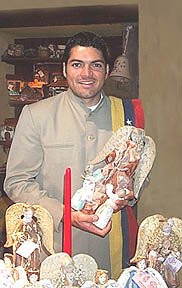Venezuela is located in northern South America, bordering the Caribbean Sea and the North Atlantic Ocean, between Colombia and Guyana.
Globalization has not managed to stamp out Venezuela's most cherished holiday traditions.
Throughout Venezuela, families make cherished versions of hallacas, a dish similar to Mexican tamales. Wrapped in plantain leaves, hallacas are composed of corn flour dough filled with chicken, beef or pork, olives, raisins, eggs and spices.
The ritual can take days because many families make hundreds of hallacas to give to friends, co-workers and relatives. Each clan, each province, prides itself on its own version.
Leftovers are rolled into a bun called bollos, a tradition handed down by 19th-century African slaves who themselves made bollos from their masters' leftovers.
"The hallacas tradition will never die. It dates back to Bolivar," said 80-year-old Blanca Perez, referring to Venezuela's 19th-century independence hero Simon Bolivar. "But I'll never buy those hallacas they sell in restaurants or supermarkets these days."
 The Christmas season begins in Venezuela on December 16th when families bring out their pesebres and display them in the most prominent part of the living room. Venezuelan presebres range from the usual depictions of the nativity scene to some rather unorthodox displays that combine modern-day electric trains, boats on the sea, and cartoon figures, along with the traditional shepherds, pilgrims, kings, and the Holy Family. On the Caribbean island of Margarita, a live nativity scene plays out every year in which a baby is taken to the creche display in a Christmas procession.
The Christmas season begins in Venezuela on December 16th when families bring out their pesebres and display them in the most prominent part of the living room. Venezuelan presebres range from the usual depictions of the nativity scene to some rather unorthodox displays that combine modern-day electric trains, boats on the sea, and cartoon figures, along with the traditional shepherds, pilgrims, kings, and the Holy Family. On the Caribbean island of Margarita, a live nativity scene plays out every year in which a baby is taken to the creche display in a Christmas procession.
Angels, as seen in the photo, are an important part of the Christmas decorations in most homes.
Venezuelans attend a daily early morning church service between December 16th and 24th called Misa de Aguinaldo. In Caracas, the capital city, it is customary to roller-skate to this service and many neighborhoods close the streets to cars until 8 a.m. Before bedtime children tie one end of a piece of string to their big toe and hang the other end of the string out the window. The next morning, rollerskaters give a tug to any string they see hanging down. After Mass everyone rushes home for tostados and coffee.